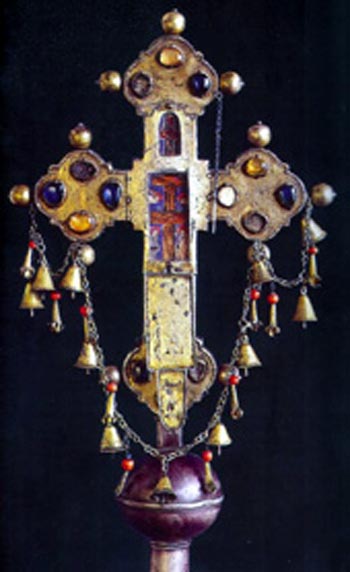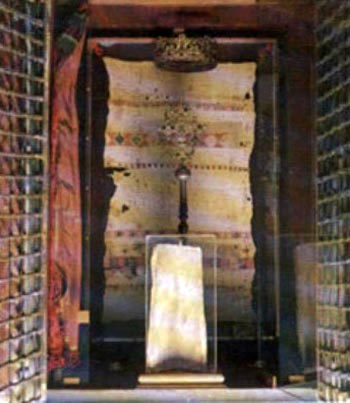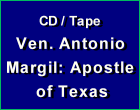Stories & Legends
 |
 |
 |
 |
 |
 |
 |
The Newlyweds, the Witch & the Mule
The Eucharistic miracle of Offida actually took place in the city of Lanciano, the site of another extraordinary miracle not related to this one. The miraculous host, however, is kept in Offida some 60 miles north of Lanciano.
The miracle occurred in 1273 and involved a newlywed couple named Ricciarella and Giacomo Stasio, their mule and a witch.
Unfortunately, soon after their marriage, the newlyweds were having problems. Giacomo was not very affectionate towards his new spouse. Ricciarella was unhappy and tried everything possible to win the love of her husband.
 Finally, someone suggested she seek the advice of a witch, who claimed to have a way for her to achieve the marriage that she desired.
Finally, someone suggested she seek the advice of a witch, who claimed to have a way for her to achieve the marriage that she desired.
The sorceress told Ricciarella what she must do to make a surefire “love potion”: "Go to Communion, but do not swallow the Host. Take it home, put it in the stove and burn it. Take the ashes and throw them into his wine or soup. You will see that he will immediately become more affectionate and loving towards you”
Ricciarella was hesitant to commit that sacrilegious crime, but she was desperate to have the love of her husband. Eventually, she worked up the courage and set out for the church to assist at Holy Mass. She received the Holy Eucharist, and then secretly let the Host fall from her mouth into the top of her dress.
After taking it home, she placed it on a coppo, a semi-circular clay tile. She then placed the tile over a fire. As soon as the Sacred Host was heated, instead of turning into powder, it began to turn into a piece of flesh. Horrified at what was taking place, Ricciarella attempted to stop the process by throwing ashes and wax onto the tile, but without success. The tile remained with a large smear of blood and the flesh.
Ricciarella panicked. Frantic to dispose of the evidence of her sacrilege, she took a linen tablecloth decorated with silk embroidery and lace and wrapped it around the tile and the bloody Host. Carrying the bundle outside, she went out to the stable and buried it under a manure heap.
When her husband returned home that evening accompanied by his work mule, he noticed that the mule was acting more stubborn than usual. The animal did not want to go into the stable. Giacomo tried pushing the mule, and then slapping it, all to no avail.
Finally, he got a whip and began beating the animal. The pain being more than the mule could endure, it reluctantly went into the barn, its eyes fixed on the dung heap. The animal fell prostrate near the dung heap, almost in a position of adoration.
 The mule had never done such an extraordinary thing before and Giacomo realized that something was causing this mysterious behavior. So, he went to his wife and accused her of placing a spell on the stable that made the animal fearful of entering it. Ricciarella denied everything and remained silent about the cause of the difficulty, which she immediately understood.
The mule had never done such an extraordinary thing before and Giacomo realized that something was causing this mysterious behavior. So, he went to his wife and accused her of placing a spell on the stable that made the animal fearful of entering it. Ricciarella denied everything and remained silent about the cause of the difficulty, which she immediately understood.
For seven years the Blessed Sacrament remained hidden there, and for that whole period of time the mule and the other animals always entered and exited the stable facing the dung heap with their eyes fixed on it.
For Ricciarella, this was the beginning of a living hell. She felt great pangs of conscience for her sin, and came to realize more and more the seriousness and consequences of her action. She was tormented day and night with remorse for her sin. Finally she decided to confess what she had done to the Prior of the Monastery of St. Agostino in Lanciano, Fr. Giacomo Diotallevi, a native of Offida.
After Ricciarella confessed her profanation to the priest, he accompanied her back to her home. They went into the stable, dug in the place Ricciarella indicated, and found the bundle. When the friar opened the tablecloth, he found that the contents of the tile, the bleeding Flesh and the Host, had remained incorrupt for that whole time.
He took the tile and the tablecloth containing the Host with him and returned to his monastery. The next day he set out for his village of Offida with the miraculous Host, which he took to Fr. Michael Mallicani, Prior of the Augustinian Monastery there. This was in the year 1280, seven years after Ricciarella had committed the terrible sacrilege.
Fr. Mallicani moved quickly. He and another friar went to Venice in the same year to have a beautiful reliquary built to honor and display the Eucharistic Miracle. They commissioned a craftsman to do the work secretly. After taking an oath of secrecy, the craftsman took the pyx containing the miraculous Host, but, struck with a sudden fever, exclaimed, “What have you brought me, Oh my brother?” The religious then asked him if he was in mortal sin. The craftsman answered, “Yes,” and made his confession to the same priest. The fever having left him, he took the pyx without any danger. Without extracting the Host, he fixed both Host and pyx, together with a piece of the True Cross, inside the same cross, with a crystal above it.
When the beautiful reliquary was completed and the priest had placed the miraculous Host inside, the friars left by boat to return to Offida. It was then that the silversmith decided to tell the local Duke of Venice what had happened.
 The Duke, anxious to have the precious miraculous Host for his own province, ordered a ship to intercept the one carrying the two friars back to Offida. But in the end, it was God who decided who should have the miraculous Host.
The Duke, anxious to have the precious miraculous Host for his own province, ordered a ship to intercept the one carrying the two friars back to Offida. But in the end, it was God who decided who should have the miraculous Host.
As the Duke's ship was about to overtake the friars, the Adriatic Sea became violent, allowing the friars to disembark at Ancona and return safely to their monastery in Offida. The reliquary was installed in the Church in Offida, and it remains there to this day. The house of the Spasio couple at Lanciano was later converted into a small chapel.
And so it is that today atop the main altar of the Sanctuary of St. Augustine in Offida, also known as the Sanctuary of the Miraculous Eucharist, the silver cross containing the miraculous Host is found. The tile on which Ricciarella heated the Host, still showing the blood smear and spots, is kept in a rectangular glass-sided case. The tablecloth in which the tile and the bloody Host were wrapped is also kept under glass. Paintings depicting the events of the miracle can also be found within the beautiful Church.
There are many documents describing this miracle, including a 13th-century parchment written by the notary Giovanni Battista Doria in 1788. There are also many official decrees of Popes, starting with that of Boniface VIII (1295) to the one of Sixtus V (1585), affirming its authenticity. In 1973, the seventh centenary of the Miracle was commemorated in Offida.


The miracle occurred in 1273 and involved a newlywed couple named Ricciarella and Giacomo Stasio, their mule and a witch.
Unfortunately, soon after their marriage, the newlyweds were having problems. Giacomo was not very affectionate towards his new spouse. Ricciarella was unhappy and tried everything possible to win the love of her husband.

The reliquary with the miraculous bleeding Host and piece of the True Cross at Offida
The sorceress told Ricciarella what she must do to make a surefire “love potion”: "Go to Communion, but do not swallow the Host. Take it home, put it in the stove and burn it. Take the ashes and throw them into his wine or soup. You will see that he will immediately become more affectionate and loving towards you”
Ricciarella was hesitant to commit that sacrilegious crime, but she was desperate to have the love of her husband. Eventually, she worked up the courage and set out for the church to assist at Holy Mass. She received the Holy Eucharist, and then secretly let the Host fall from her mouth into the top of her dress.
After taking it home, she placed it on a coppo, a semi-circular clay tile. She then placed the tile over a fire. As soon as the Sacred Host was heated, instead of turning into powder, it began to turn into a piece of flesh. Horrified at what was taking place, Ricciarella attempted to stop the process by throwing ashes and wax onto the tile, but without success. The tile remained with a large smear of blood and the flesh.
Ricciarella panicked. Frantic to dispose of the evidence of her sacrilege, she took a linen tablecloth decorated with silk embroidery and lace and wrapped it around the tile and the bloody Host. Carrying the bundle outside, she went out to the stable and buried it under a manure heap.
When her husband returned home that evening accompanied by his work mule, he noticed that the mule was acting more stubborn than usual. The animal did not want to go into the stable. Giacomo tried pushing the mule, and then slapping it, all to no avail.
Finally, he got a whip and began beating the animal. The pain being more than the mule could endure, it reluctantly went into the barn, its eyes fixed on the dung heap. The animal fell prostrate near the dung heap, almost in a position of adoration.

The bloodstained tablecloth behind the tile (in a glass case) and reliquary over it
For seven years the Blessed Sacrament remained hidden there, and for that whole period of time the mule and the other animals always entered and exited the stable facing the dung heap with their eyes fixed on it.
For Ricciarella, this was the beginning of a living hell. She felt great pangs of conscience for her sin, and came to realize more and more the seriousness and consequences of her action. She was tormented day and night with remorse for her sin. Finally she decided to confess what she had done to the Prior of the Monastery of St. Agostino in Lanciano, Fr. Giacomo Diotallevi, a native of Offida.
After Ricciarella confessed her profanation to the priest, he accompanied her back to her home. They went into the stable, dug in the place Ricciarella indicated, and found the bundle. When the friar opened the tablecloth, he found that the contents of the tile, the bleeding Flesh and the Host, had remained incorrupt for that whole time.
He took the tile and the tablecloth containing the Host with him and returned to his monastery. The next day he set out for his village of Offida with the miraculous Host, which he took to Fr. Michael Mallicani, Prior of the Augustinian Monastery there. This was in the year 1280, seven years after Ricciarella had committed the terrible sacrilege.
Fr. Mallicani moved quickly. He and another friar went to Venice in the same year to have a beautiful reliquary built to honor and display the Eucharistic Miracle. They commissioned a craftsman to do the work secretly. After taking an oath of secrecy, the craftsman took the pyx containing the miraculous Host, but, struck with a sudden fever, exclaimed, “What have you brought me, Oh my brother?” The religious then asked him if he was in mortal sin. The craftsman answered, “Yes,” and made his confession to the same priest. The fever having left him, he took the pyx without any danger. Without extracting the Host, he fixed both Host and pyx, together with a piece of the True Cross, inside the same cross, with a crystal above it.
When the beautiful reliquary was completed and the priest had placed the miraculous Host inside, the friars left by boat to return to Offida. It was then that the silversmith decided to tell the local Duke of Venice what had happened.

The Sanctuary of St. Augustine in Offida, also known as the Sanctuary of the Miraculous Eucharist
As the Duke's ship was about to overtake the friars, the Adriatic Sea became violent, allowing the friars to disembark at Ancona and return safely to their monastery in Offida. The reliquary was installed in the Church in Offida, and it remains there to this day. The house of the Spasio couple at Lanciano was later converted into a small chapel.
And so it is that today atop the main altar of the Sanctuary of St. Augustine in Offida, also known as the Sanctuary of the Miraculous Eucharist, the silver cross containing the miraculous Host is found. The tile on which Ricciarella heated the Host, still showing the blood smear and spots, is kept in a rectangular glass-sided case. The tablecloth in which the tile and the bloody Host were wrapped is also kept under glass. Paintings depicting the events of the miracle can also be found within the beautiful Church.
There are many documents describing this miracle, including a 13th-century parchment written by the notary Giovanni Battista Doria in 1788. There are also many official decrees of Popes, starting with that of Boniface VIII (1295) to the one of Sixtus V (1585), affirming its authenticity. In 1973, the seventh centenary of the Miracle was commemorated in Offida.

Posted June 29, 2013






